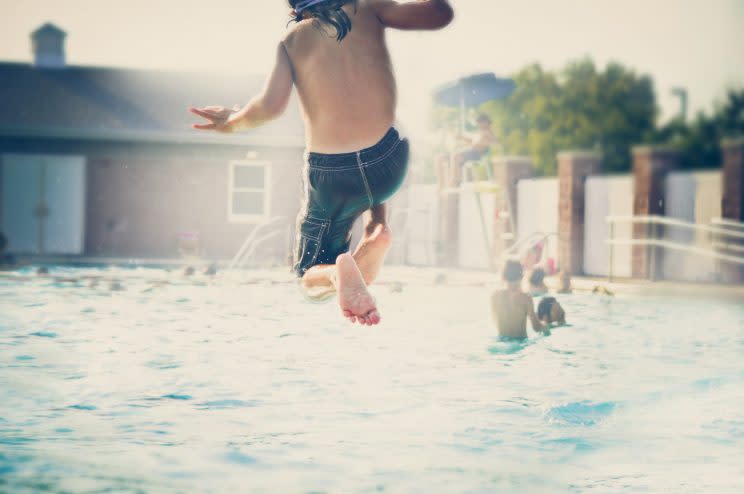After 4-Year-Old's 'Dry Drowning' Death, What Parents Need To Know

Every summer, it seems, there is at least one horrifying story that drives parents’ anxiety through the roof, making them reconsider letting their little ones out of the house at all. This week’s sudden death of 4-year-old Francisco Delgado III is one of those stories. According to his parents, Frankie woke up in the middle of the night unable to breathe, and paramedics could not resuscitate him. Because he had been swimming a week before and complained briefly of a stomachache afterwards the EMT on the scene told his parents he was a victim of “dry drowning.”
Before this tragedy causes you cancel all your beach and pool trips for the season, take a minute to familiarize yourself with the facts of drowning. It ranks fifth among leading unintentional deaths in the U.S. for children and adults — about 10 deaths every day, according to the CDC. But most of those incidents do not occur so mysteriously, and death can often be prevented.
What Is Drowning?
The type of drowning everyone thinks of associated with the term is “wet drowning.” When a person is suddenly submerged in water and it goes into their throats, their vocal cords close off the airway in what’s called a laryngospasm. In wet drowning, the spasm subsides and then the person breathes water into his or her lungs, preventing them from getting oxygen and causing them to pass out. This is what happens in 85-90 percent of drowning cases.
Dry drowning, which happens in 10-15 percent of cases, occurs when that laryngospasm continues to block the airway for a prolonged period. Without air, the body goes into hypoxia, a lack of oxygen, causing a seizure or cardiac arrest.
Dr. Mark Waltzman, a senior associate in medicine at Boston Children’s Hospital and assistant professor of pediatrics at Harvard, explained to Yahoo Beauty that what Frankie likely experienced was not “dry drowning” but neurogenic pulmonary edema. That can happen when a small amount of water goes in the back of the throat and causes a person’s vocal cords to spasm and close off the airway. The lungs keep struggling to work, however, and blood in the heart has nowhere to go. Because of this pressure, the fluid eventually enters the lungs, much like it does in pneumonia.
“The fluid shift can happen up to 24, sometimes 48 hours after the event, which is why, for any significant drowning, we admit patients for observation, even if they’re perfectly fine when they get to the ER,” Waltzman said. “If there is any need for resuscitation at the scene. If there is any difficulty breathing, we observe them.”
Though he does not know the specifics of Delgado’s case, Waltzman said that the standard literature does not include any cases of pulmonary edema happening a full seven days after an incident in the water. It’s possible something else caused the pulmonary edema, such as an allergic reaction that blocked his airway, or a foreign object inhaled in his lungs. According to ABC13, there will be an autopsy conducted to determine the boy’s cause of death.
What Can Parents Do?
Give them swimming lessons. “I taught my daughter how to swim by the time she was 18 months old,” Waltzman said, because he thinks that’s the most important preventative measure against drowning.
Supervise even the champion swimmers. “Most drownings in kids happen in the late afternoon, 4-7 pm, and it’s usually because everybody is at the swimming pool hanging out, and parents are having a little party and people really aren’t watching the kids that much,” Waltzman said.
Have a CPR-certified person nearby at all times. Those lifeguards aren’t just there to yell at rowdy kids. “Most kids are salvageable [after drowning],” Waltzman explained. “Ninety percent of children end up doing perfectly fine, and up to 68 percent of patients needing CPR have a good outcome eventually.” Their survival depends on how quickly and how correctly the resuscitation occurs.
Keep toddlers away from the smallest amount of standing water. Just an ounce of water in a 1-year-old’s lungs can decrease his or her oxygen level.
If someone has lost consciousness due to drowning, take them to the hospital for observation. If they didn’t appear to lose consciousness, just keep an eye out for persistent coughing, which could be a sign of pulmonary edema and cause for a trip to the doctor.
Otherwise, Waltzman said, “If kids are splashing about in the water and they cough and sputter a little bit but they never lose consciousness, they recover relatively quickly and they’re back to normal, in my mind they’re perfectly fine and there’s nothing to do for them.”
Read more from Yahoo Beauty + Style:
Mom Shocked to Find Son’s Class Picture Digitally Altered by Photo Company
Jewish Nurse Steps In to Breastfeed Palestinian Baby After His Parents Are in a Car Accident
Follow us on Instagram, Facebook, and Pinterest for nonstop inspiration delivered fresh to your feed, every day. For Twitter updates, follow @YahooStyle and @YahooBeauty.

